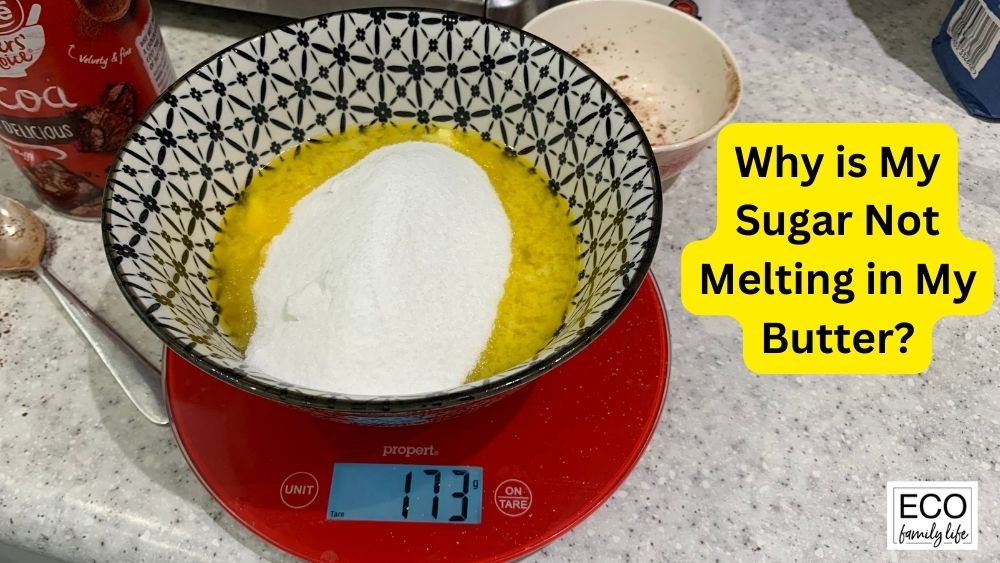If you’ve ever tried to make a recipe that involves melting sugar into butter, you may have noticed that the sugar doesn’t always dissolve properly. This can be frustrating and may result in a gritty or clumpy texture in your finished dish. Sugar may not melt into butter if you are using coarse sugar, cold butter, not heating the mixture enough, or not stirring it properly.
This article will explore the top 8 reasons why sugar will not melt into butter and how to solve each one.

How to melt sugar and butter together
Here are the top reasons why sugar won’t melt into butter and some tips that will make the process a little easier.
1. The Butter is Too Cold
If the butter is too cold it will make it more difficult to melt it together with your sugar. Starting your butter at room temperature, around 68–72 degrees Fahrenheit will make it easier to mix them both together.
2. Not Stirring for Long Enough
Stirring the butter and sugar well is crucial, but you need to take your time and stir it until the sugar has dissolved. If you’re stirring by hand, it’s easy to get tired of stirring and quit. To make the task easier and make sure you’re stirring long enough, use a stand mixer and a K paddle.
3. Over-mixing
Just as you can under-stir your butter and sugar mixture, you can also stir it too much. Several things can happen when you do this. It might cause the sugar to become overworked and not dissolve properly, or the butter can start to either separate or change color.
For the best results, stop mixing as soon as you notice that the sugar is completely dissolved in the butter. Keep in mind that if you’re using brown sugar, it will naturally be darker and doesn’t necessarily mean you’ve stirred too much.
4. It is Extra Humid
When it is humid outside, your sugar may absorb more moisture than it usually does, causing it to clump. The larger the clumps, the more difficult it is to absorb once you put it in the butter. The best thing you can do to avoid this is to always keep all types of sugar in an airtight container whenever it isn’t being used.
5. Using Too Much Sugar
Too much sugar is naturally going to take longer to dissolve. Regardless of the recipe, it’s important to weigh your ingredients with a kitchen scale so the measurements are exact.
Start by mixing a small amount of sugar in and gradually add the rest. This will give you the chance to dissolve all of the added sugar before adding more.
6. Adding the Sugar Too Late
Recipe instructions have to be followed to the letter in order for the food to come out just right. If you add the sugar too late, it simply doesn’t have enough time to dissolve properly.
If you’re creaming butter and sugar together instead of trying to dissolve sugar into melted butter, it’s a little easier, but make sure the sugar is added at the right time if you want the best results.
7. The Type of Your Sugar Matters
When melting sugar into butter, you have to consider whether you’re using white sugar, powdered sugar, brown sugar, or a specialty type of sugar.
Powdered sugar is finer than white or brown sugar, so it’s much easier for powdered sugar to dissolve more easily and more evenly in the butter. When you use sugar with larger crystals, such as brown or white sugar, you might want to blend it for a few seconds first.
8. Using a Low-Quality Sugar
Low-quality brands of sugar tend to clump more and be more difficult to work with each step of the way. This is why it’s important to buy name brands that are reputable and known to sell quality sugar products.
Low-quality sugars might clump more or crumble too much, making it difficult to mix in with the butter.
7 Tips to help butter to melt together with sugar
- Use granulated white sugar instead of brown sugar, as it is easier to dissolve.
- Cut the butter into small pieces or use melted butter to help it mix more easily with the sugar.
- Use a heavy-bottomed saucepan to prevent butter and sugar mixture from burning or sticking.
- Heat the butter and sugar over low to medium heat, stirring constantly, until the sugar has completely dissolved.
- Use a metal whisk to help break up any clumps and create a smooth consistency.
- Use a candy thermometer to monitor the temperature of the mixture, ensuring that it doesn’t get too hot and burn.
- Don’t rush the process, as sugar can take time to dissolve properly.
Summary
Not being able to dissolve your sugar in butter can be frustrating, but the solution is usually very simple. Make sure the butter is at room temperature, you aren’t stirring too much or too little, and you’re using the right type of sugar. You can gently heat the mixture on the stove or whisk with a metal spoon or whisk.
I am an accredited practicing dietitian, experienced gardener and a dedicated cook. I love writing and sharing my experience so you can learn from my successes and mistakes.
